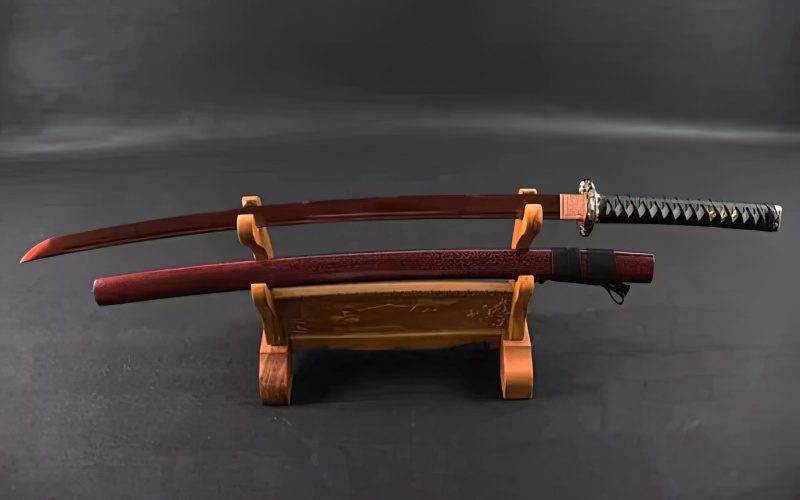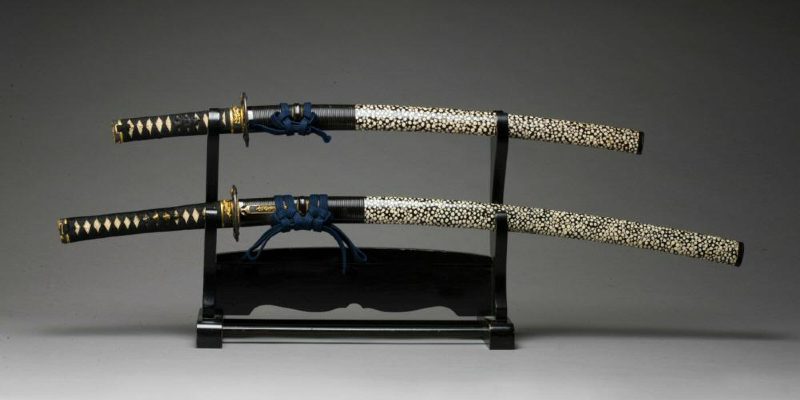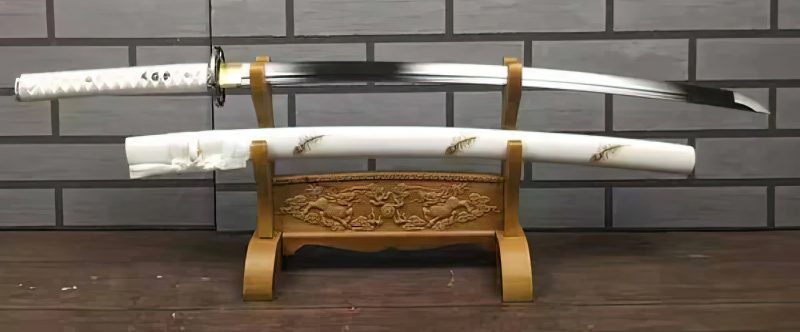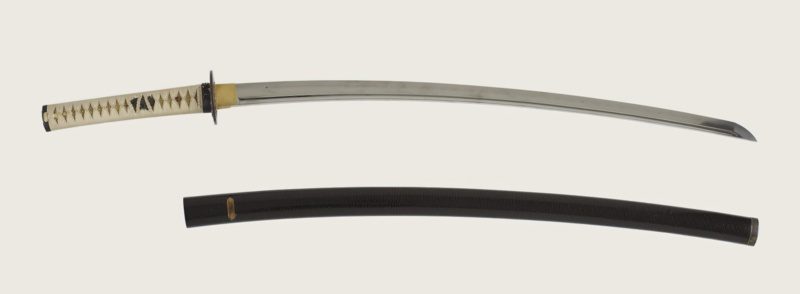Uchigatana Sword: How It Evolved Into the Modern-Day Katana

What’s in this article?
Unlike other Japanese swords valued for their artistic features and craftsmanship, the uchigatana served more as a practical fighting weapon. Worn with its cutting edge upwards, it allowed the warrior to respond faster in combat, a factor which is often the difference between life and death.
Let’s explore the history and evolution of the uchigatana sword and how it compares to the modern katana.
What Exactly Is an Uchigatana?
The term uchigatana refers to a blade or sword type that was worn with its edge up, contrary to the earlier tachi sword, which was worn slung from the belt with its edge down. With the uchigatana, the action of drawing the sword from the scabbard becomes the action of striking. It is contrary to the wearing of the tachi sword, which needed two separate drawing and cutting movements.
Also, the uchigatana could be drawn with only one hand because its scabbard was secured in the belt. This is unlike the tachi which needed two hands for it to be drawn. The uchigatana sword was initially used by low-ranking warriors and persons not belonging to the warrior class before being adopted by higher-ranking warriors at a later timeline.
At first, the uchigatana complemented the tachi sword, but it eventually became so popular that it replaced the tachi sword. Longer heavier-duty versions of the uchigatana were then developed, resulting in the curved katana. Eventually, wearing a pair of long and short uchigatana swords together became a custom, the sword pair known as daisho.

More than that, the term uchigatana which refers to a blade and sword type, is sometimes used to refer to the historical blade alone or sword mountings in general. The term uchigatana–koshirae may also refer to mountings of the uchigatana itself or those swords mounted in an uchigatana style, differentiating them from tachi-style mountings.
Characteristics of Uchigatana Sword
The most distinguishable feature of the uchigatana swords is how they were worn. They were practical fighting swords but also had qualities similar to highly valued Japanese swords.
Here are the characteristics of the uchigatana sword:
Metal and Construction
Early uchigatana swords were often roughly made and considered disposable—so virtually no examples from the Heian and Kamakura periods have survived today. Many were mass-produced swords to supply the armies for war and mostly based on functionality rather than aesthetics.
In the later periods, there were better quality swords, likely because some warriors began to use them as a companion weapon to the tachi, or perhaps some fine old tachi swords were shortened and mounted as uchigatana.
Since the earliest times, Japanese swordsmiths clay tempered their blades by covering them with clay to harden the cutting edges. Nihonto, or traditionally-made Japanese swords, are made from tamahagane, using traditional sword making methods. However, modern sword making focuses on modern katana instead of the uchigatana sword it developed from.
Today, the so-called battle-ready katana used in tameshigiri or test cutting practice often have high carbon steel blades with proper tempering and full tang, so they are unlikely to break upon impact.
Blade Appearance

Initially, the uchigatana had a straight blade, making it an efficient stabbing weapon. Eventually, curved versions emerged, resulting in the katana, a single-edged curved blade. Early blades were flat and ridgeless, often described as hira-zukuri. However, Muromachi-period uchigatana blades had to be forged in shinogi-zukuri, as the hira-zukuri would not be sturdy for a longer blade.

Some historical uchigatana had a straight, narrow hamon, the visible pattern of the hardened sharp edge. However, its hamon was more functional than artistic. Many examples also had short tangs, making them single-handed and relatively lightweight swords. Like all Japanese blades, the uchigatana had a sword collar or habaki that held it snugly in the scabbard.
Size and Length
The uchigatana greatly varied in size in different periods. Heian-period uchigatana had a blade length between 30.3 to 39.4 centimeters or 11.9 to 15.5 inches, making it more like a sunnobi tanto, a large dagger, or a ko-wakizashi, meaning small wakizashi. Low-ranking warriors or civil servants used this shorter uchigatana.
By the mid-Muromachi period, uchigatana had blade lengths of more than 60.6 centimeters or 23.8 inches, which would classify it under the modern-day definitions of a Japanese katana. Also, the famous sword hishizukuri-uchigatana, the earliest surviving example with the name uchigatana, had a blade length of 45.5 centimeters, which could be considered a short sword or wakizashi.
Sword Mounting

The earliest uchigatana swords had simple mountings without a sword guard, though Momoyama-period ones often came in elaborate mountings or koshirae.
Hilt or Tsuka
The earliest uchigatana swords had plain wooden hilts and were limited to basic tsuka-maki or hilt wrapping. Muromachi-period uchigatana with a short tang are called katate-uchi, a generic term for a sword designed for single-handed use. It was one of the forerunners of the wakizashi.
Sword Guard or Tsuba
Early uchigatana swords usually lacked a tsuba and had an aikuchi mounting in which the hilt and the scabbard meet without the sword guard. By the early Muromachi period, uchigatana usually had an iron tsuba. The outdated term tsuba-gatana simply describes an uchigatana sword with a tsuba. However, its sword guard was often plain and had little to no decoration or small openings.
In late Muromachi period, when warriors began to wear longer uchigatana swords with tsuba, some artisans created openwork designs. However, sword guards made of soft metal pieces such as copper, brass, and shakudo—or a copper alloy with small amounts of gold—are no earlier than the Momoyama period from 1574 to 1600.
Scabbard or Saya

The earliest uchigatana swords had scabbards (saya) wrapped in rattan. However, those from the Momoyama-period were mostly elaborat, with some called kin-arare (gold hail). The uchigatana–koshirae also had a kojiri, often a horn fitting protecting the end of the scabbard.
The uchigatana–koshirae often had a kurigata, a term that literally means “chestnut shape” to allow the wearer to thrust the sword through the belt, fastened through a sageo cord. The kurigata was usually made of horn, though later Edo-period swords usually had metal ones. It also had the kaerizuno or origane to prevent it from slipping out from the belt.
The bushi warriors usually carried the uchigatana sword thrust edge-up through the belt—the buke-zukuri way—so it could be smoothly drawn and used for an immediate strike. Still, some accounts mention that the lower-ranking bushi used a koshiate, a leather fitting with cords to wear their uchigatana sword in a tachi way, with the cutting edge facing downwards. The koshiate, meaning “at the hip” or “to the hip”, had several forms ranging from tubular tsutsu-koshiate to flat ita-koshiate.
Koshirae Types
Some historical uchigatana swords were equipped with distinctive koshirae, though these elaborate mountings may not be exclusive to them. In some contexts, an uchigatana koshirae may refer to most koshirae worn in this manner throughout the Edo period.
Kaifu-Koshirae

During the transitional period from the Nanbokucho to the Muromachi, a school of swordsmiths with the name Kaifu emerged and became famous for their blades. The kaifu blades were often mounted in aikuchi style without the sword guard and had scabbards wrapped in rattan. Such blades and mountings were similar to the earliest uchigatana swords, which some sources describe as being in aikuchi-koshirae.
Tensho-Koshirae

Having derived its name from the Tensho era from 1573 to 1592, the tensho-koshirae was simple and practically oriented. The uchigatana swords of the period were in demand, so they were mounted in a black lacquered saya, leather hilt wrapping, and horn fittings.
Kin-Arare
In the Momoyama period, the kin-arare-saya uchigatana–koshirae was exceptional and elaborate. Its scabbard was divided into two sections, separated by a diagonal border. The upper portion was lacquered dark blue while the lower was covered with gilded ray skin.
Uchigatana Sword vs. Katana Sword

In modern times, the katana is a generic term for a curved Japanese blade measuring over 60 centimeters, worn with the edge up in the obi belt. It developed from the uchigatana and became the sword of the samurai class in feudal Japan.
Early uchigatana swords, even those yet to be called by that name, had straight blades, making them suitable for stabbing. They were often crudely made until curved heavy-duty versions were developed which later became the katana, the slashing weapon of the samurai.
Also, the katana samurai sword was exclusive to the warrior class. On the other hand, the uchigatana was originally used by people of low status, persons not belonging to the warrior class—and mostly low-ranking warriors before being adopted by high-ranking persons.
Unlike the katana with a two-handed grip, many historical uchigatana swords had a short hilt for single-handed use. They sometimes lacked a sword guard (tsuba) and can be mounted in aikuchi-koshirae which was rarely seen on a katana.
History of the Uchigatana Sword
The name uchigatana literally translates as striking sword, suggesting that the warriors used it for striking as if they were using a stick. It gained popularity during the Muromachi period, though some historians believe it was first introduced in the earlier Heian period.
Koto Era
Also known as the Old Sword period, the Koto era spanned from the mid-Heian period until the end of the Momoyama period. Japanese swords made during the era are referred to as koto or old swords. However, exact dates usually vary in different sources because Japanese sword eras and historical periods do not correspond to the Western calendar years.
In the Heian Period (794 – 1185)
The low-ranking kebiishi officers, a body of police commissioners and a military force, likely used the uchigatana during the period, though the sword was not described with that name. In the famous scroll the Ban Dainagon Ekotoba, the Story of the Courtier Ban Dainagon, a kebiishi official is drawing his uchigatana in the same way the later katana is drawn.
Some accounts also mention the Japanese ruler Taira Kiyomori who wore a large uchigatana, suggesting that some high-ranking warriors occasionally used the sword.
Misayuki Sasano, a noted authority on Japanese sword guards, suggests that the sword guard (tsuba), the kozuka—handle of a small knife kogatana—and kogai hairpin also began their production when the uchigatana was used. However, no surviving examples of swords and mountings from the Heian and Kamakura periods that could be certainly classified as uchigatana.
In the Kamakura Period (1192 – 1333)
Low-ranking warriors, individuals not belonging to the warrior class, and people of low status used uchigatana-like swords to defend themselves. On the other hand, the warrior class of the Kamakura period—even those of the Heian and the beginning of the Sengoku period—relied on the tachi sword used on horseback. They wore the tachi hanging at their waist with the cutting edge downwards.
The high-ranking warriors also used a companion weapon or sashizoe called koshigatana, which was worn through the belt. As an accompaniment to the tachi, the koshigatana served as a close-combat weapon and a blade for severing the head of their enemies. However, it is difficult to make a clear distinction between the early uchigatana and koshigatana as there are only a few surviving examples.
Some accounts describe the uchigatana as being larger than the koshigatana and the former had a curvature. The uchigatana likely emerged from the gradual lengthening of the koshigatana, which was also worn through the belt with its cutting edge up. The latter was equipped with kozuka and kogai, which were later incorporated into the uchigatana-koshirae.
In the Nanbokucho Period (1331 – 1392)
By the beginning of the Nanbokucho period, the uchigatana-like swords disappeared to make way for the sunnobi tanto, the oversized dagger of the period which can now be classified as a wakizashi. It was the time when the samurai warriors also used their extra-long swords called nodachi or odachi and fought on foot rather than on horseback.
The earliest known mention of the name uchigatana comes from the famous sword hishizukuri-uchigatana, preserved in Kasuga-taisha in Nara. Chancellor Hamuro Nagamune once offered the sword to the shrine in 1385. The term hishizukuri refers to its mounting, such as the makie ornamentation on sword scabbard, where silver or gold dust was applied to the lacquer.
In the Muromachi Period (1338 – 1573)
Within the Muromachi period emerged the Sengoku period from 1467 to 1568, when Japan was in constant civil war. The warfare relied on foot soldiers who needed an uchigatana sword that could be drawn quickly and easier to use in combat. Also, it could be wielded with one hand and was more practical in enclosed spaces such as buildings.
The uchigatana eventually replaced the koshigatana as a sashizoe or companion weapon to the tachi, worn by high-ranking warriors on the battlefield. Japanese military leader Uesugi Kenshin even preferred a long uchigatana, so he could use it in case of a surprise attack on a field camp when the tachi was stored away by the sword carrier.
By the end of the Muromachi period, the uchigatana sword evolved into the katana and replaced the tachi sword. Japanese swordsmiths also began to forge it in long and short lengths, with the short sword called wakizashi.
In the Momoyama Period (1574 – 1600)
During this period, it became traditional for the daimyos to gift swords to their valued retainers as rewards. Hence, sword mountings became more elaborate and expensive. The uchigatana swords of the period were either mounted functionally for combat use or ornately, with costly decorations and metal fittings. The latter usually served as gifts for higher-ranking warriors.
Shinto Era
Also known as the New Sword era, the Shinto era spanned from around 1597 to 1780. Swords produced in this era are referred to as shinto which translates to “new swords”.
In the Edo Period (1603 – 1867)
By the beginning of the Edo period, wearing of the daisho or paired swords among the samurai class became popular. It consisted of a long sword katana and a short sword wakizashi, either mounted for practical combat or ceremonial use.
The Uchigatana Sword in Modern Times
The katana is the most popular type of Japanese sword and the primary weapon in martial arts. On the other hand, the uchigatana is known for its lower-quality construction even though it led to the development of the modern katana. Still, the uchigatana sometimes makes an appearance as a weapon in video games, such as Elden Ring and Dark Souls.
Conclusion
Like most Japanese swords, the uchigatana developed due to the changing form of warfare in Japan. Worn with its cutting edge upwards, it allowed both the drawing and cutting actions to be executed at the same time. Eventually, the uchigatana were worn in both short and long lengths, resulting in the daisho pair of long sword katana and short sword wakizashi we know today.




